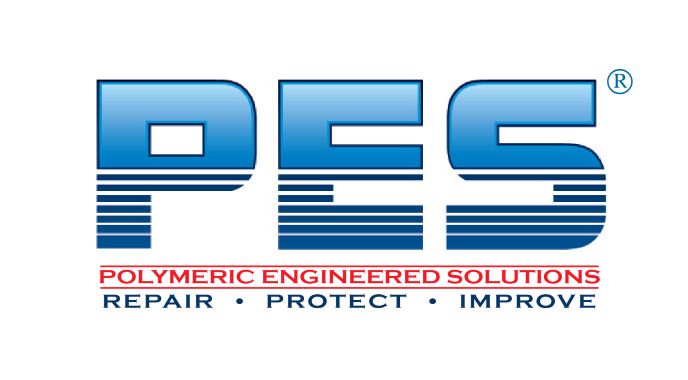PES 574 is a high performance mortar designed for use as a heavy duty repair system for concrete and mineral surfaces.
PES 574 is based on a blend of solvent free epoxy resins in poly-amino amine adducts reinforced with a special blend of silica quartz minerals and inorganic fillers which have been specially selected to provide optimum application and performance properties together with a high level of adhesion, abrasion, impact and chemical resistance.
PES 574 is a unique repair system, easy to apply by trowel or float with no shrinkage or volume change during cure and is ideal for the repair of damaged concrete, sills, lintels, steps, ramps, walkways and loading bays.
Before proceeding, please read the following information carefully to ensure that the correct application procedure is fully understood.
Surface Preparation
Surfaces to be repaired with PES 574 must be clean, dry and free from contamination.
Old concrete surfaces must be thoroughly cleaned with a detergent solution and then washed with clean water and allowed to dry.
New concrete surfaces will generally have laitance on the surface and this must be removed by mechanical means. All existing coatings must be removed from the surface before any repair is carried out. Failure to do this will mean the PES 574 bond is only as good as the existing coating.
Thorough cleaning and roughening of any surface to which PES 574 is being applied is absolutely essential for a successful repair.
Abrasion of surfaces will cause dusting and therefore all loose dust should be vacuumed clear before the application commences.
Priming
To obtain maximum penetration and adhesion, the repair area should always be primed with PES 574 Primer. PES 574 Primer consists of a base component and an activator component. The contents of the activator component should be added to the base unit. Mix thoroughly to produce a uniform material. If only small quantities are required then the PES 574 Primer can be mixed in the ratio 2 parts base to I part activator.
The mixed primer should be applied immediately using a stiff bristle brush, working the material into the prepared surface to obtain maximum penetration. PES 574 Primer will generally apply at coverage rate of 4ft² per 100gms of primer (0.37m²).
PES 574 Primer must be used as a tack coat and should not be allowed to dry – any areas of primer which have been allowed to dry should be re-primed for optimal results.
Mixing
PES 574 is a three component material comprising a base component, activator component and aggregate.
The aggregate component should be removed from the plastic container. The base and activator components should be emptied into the container and mixed thoroughly to produce a uniform material.
The PES 574 aggregate should immediately be added to the base and activator mix until the desired consistency is achieved. For bonding and grouting applications approximately two-thirds of the aggregate should be added.
For resurfacing and general repairs, all the aggregate should be added; The complete material should be mixed thoroughly for 2-3 minutes to produce a uniform material. Prolonged hand mixing or mixing by mechanical mixer will produce a wetter mix.
If only small quantities are required the PES 574 base and activator can be mixed in the ration of 2 parts base t o1 part activator, with the appropriate quantity of aggregate.
The mixed material should be used within 70 minutes of mixing at 68°F (20°C). This time will be reduced at higher temperatures and extended at lower temperatures.
Application
The mixed PES 574 should be applied to the primed area by float or trowel. The material should be spread firmly and evenly onto the surface and then smoothed over with a steel trowel or float.
On horizontal surfaces PES 574 can be applied to virtually any thickness. A thickness of 0.25 inches (6 mm) is recommended.
On vertical surfaces, the maximum thickness which can be achieved without sagging is 0.5 inches (1 2.5 mm). An application thickness of 0.25 inches (6 mm) is recommended.
When applied at 0.25 inches (6 mm) PES 574 will provide a coverage rate of 4 ft (0.37 m²) per 5 kg unit. PES 574 cannot be readily applied to overhead surfaces without the use of shuttering. Where applications to overhead surfaces are being considered, customers should consult the PES Service Department.
NOTE: The minimum temperature of application is 50°F (5°C).
On certain repairs there may be adjacent areas where PES 574 is not required to bond. By applying PES Release Agent to these surfaces, before the PES 574 is applied, then after curing, a simple release can be achieved.
All equipment must be cleaned IMMEDIATELY after use with PES Universal Cleaner.
Volume Capacity
29 cu Ins (450 cc) per kilo.
Detailed working recommendations are available from the Technical center on request.
Physical Constants
Mixing ratio
Mix as supplied.
Appearance
Primer Base: Clear Pale Straw Liquid
Primer: Clear Amber Liquid
Base: Clear Pale Straw Liquid
Activator: Clear Amber Liquid
Aggregate: Colored Granular Powder
Drying & Cure times at 68°F (20°C)
PES 574 Primer
Usable Life: 30 minutes
Maximum Overcoating: 3 ½ hoursPES 574
Usable Life: 70 minutes
Foot Traffic: 8 hours
Full Hardness: 24 hours
Maximum Overcoating: 24 hours
Full Cure: 7 days
Volume Solids
100%
V.O.C. — Nil
Shelf Life
Use within 5 years of purchase. Store in original sealed containers as temperatures between 40°F (5°C) and 86°F (30°C).
Physical Properties
Abrasion Resistance
ASTM D4060
145 mg weight loss per 1000 cycles – I kg load – CSI 7Wheel
Impact Resistance
ASTM D256
1.8 Joules (1 6 in 1 bs)
Direct Pull Adhesion
ASTM D4541
35 kg/cm¹ (500 psi) – concrete
(Concrete Failure)
Compressive Strength
ASTM D695
880 kg/cm¹ (1 2500 psi)
Flexural Strength
ASTM D790
490 kg/cm² (7000 psi)
Shrinkage
ASTM C246
NII
Health and Safety
As long as normal good practice is observed PES 574 can be safely used.
Protective gloves should be worn.
A fully detailed Material Safety Data Sheet is either included, with the material or is available on request.
Packaging
Supplied in 5 kg and 1 5 kg packs.
The information in this Product Data Sheet is intended as a general guide only and should not be used for specifications purposes. The information is given in good faith but we assume no responsibility for the use made of the product or this information because this is outside the control of the company. Users should determine the suitability of the product for their own particular purposes by their own tests.

